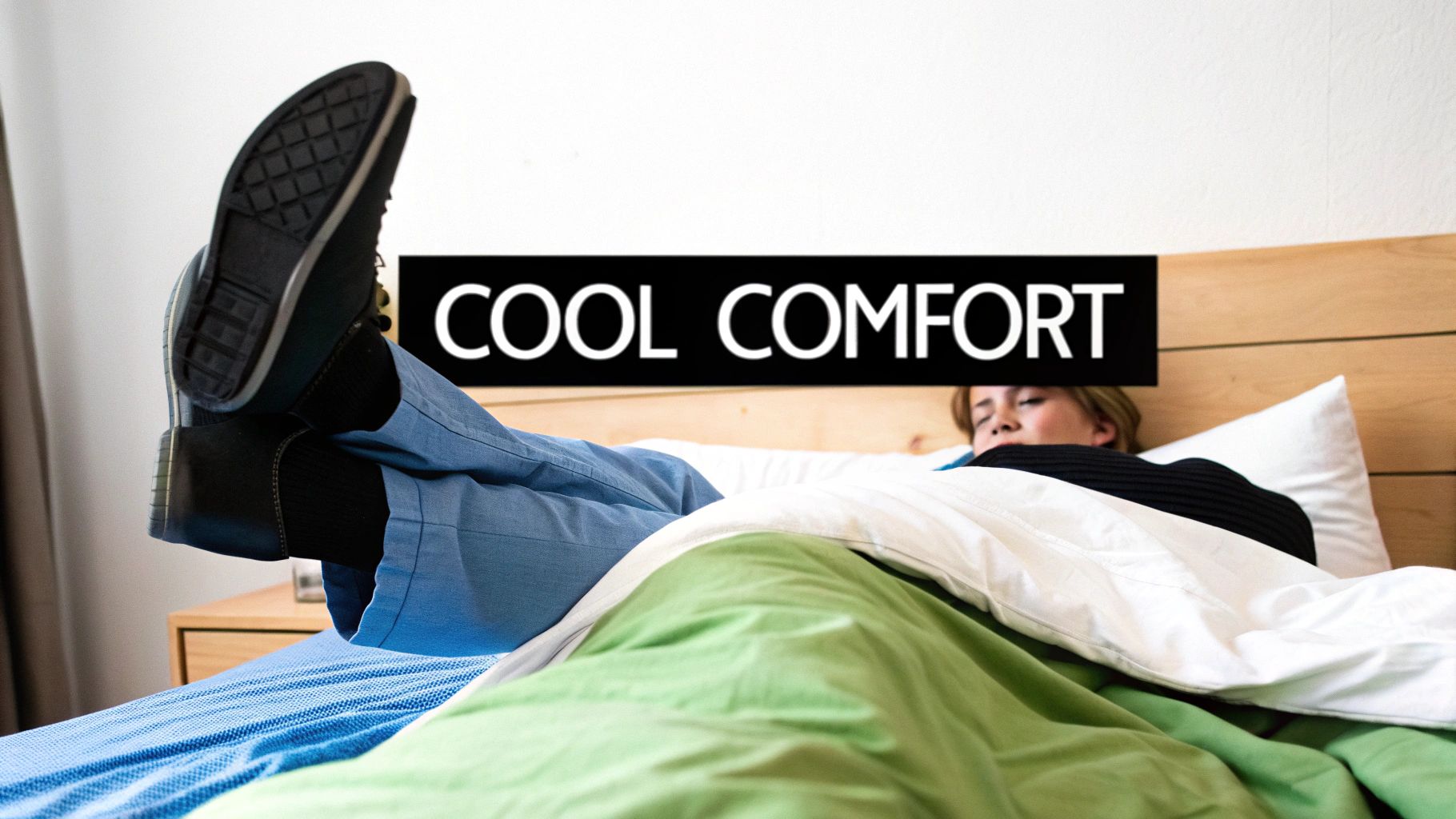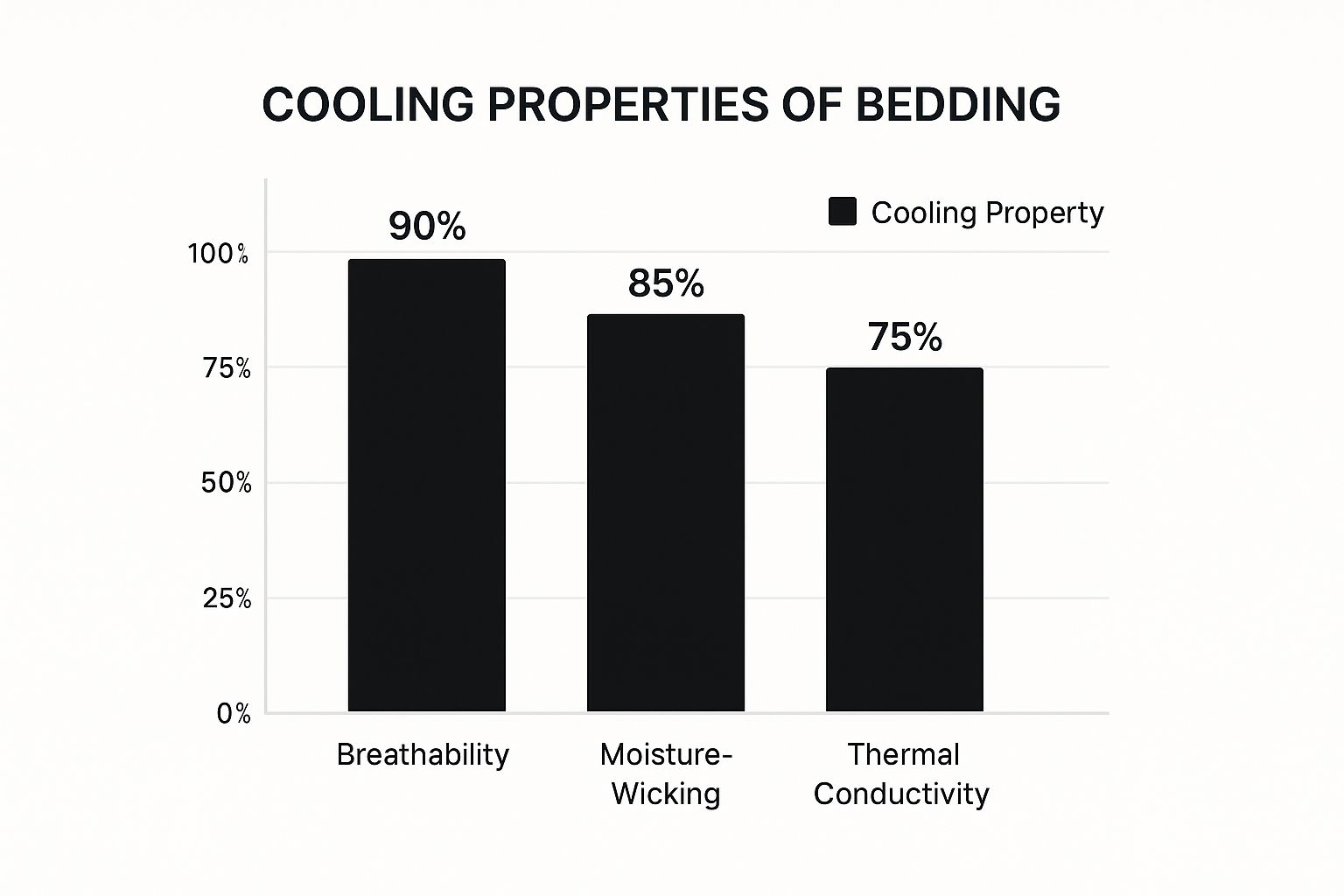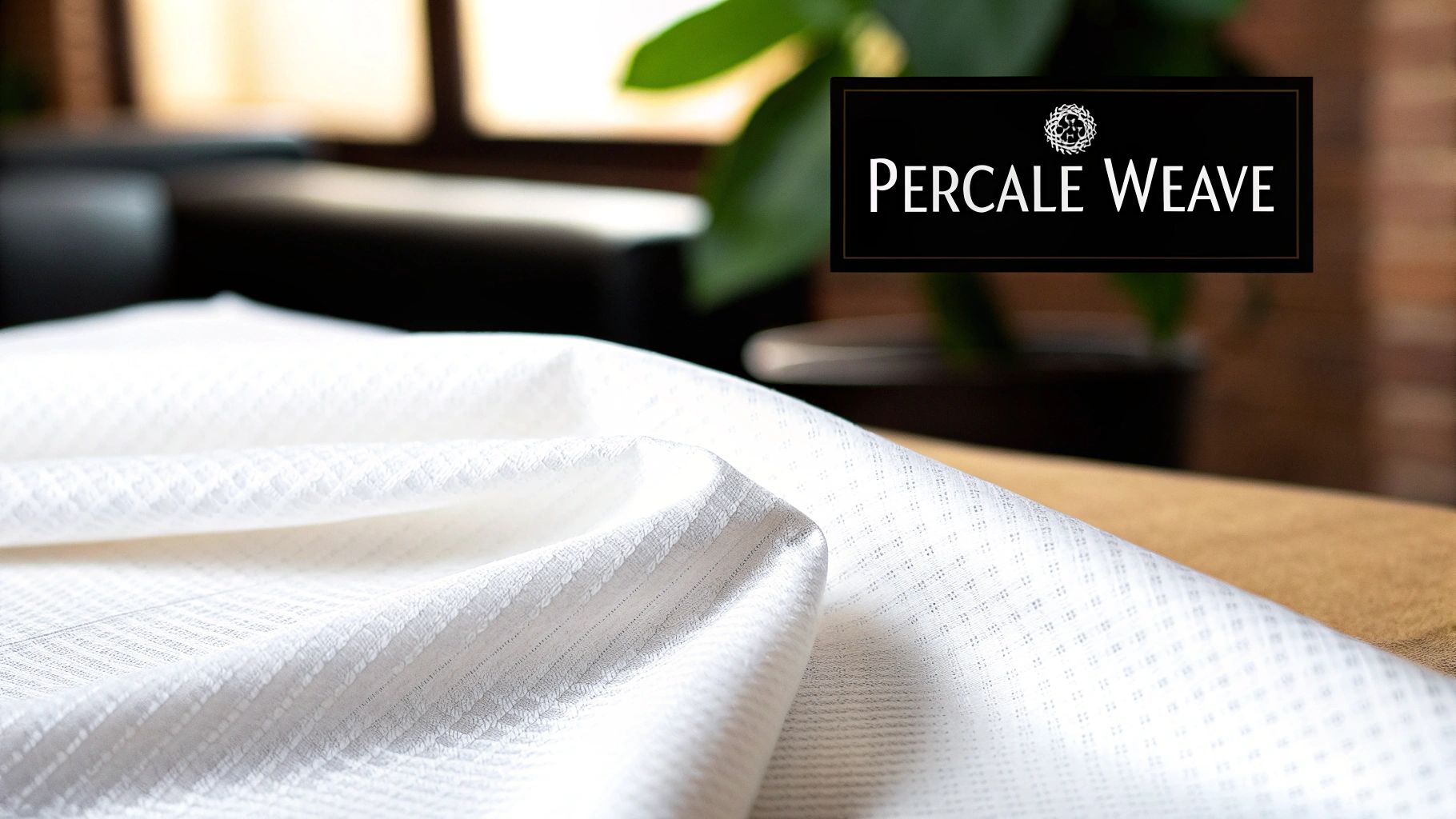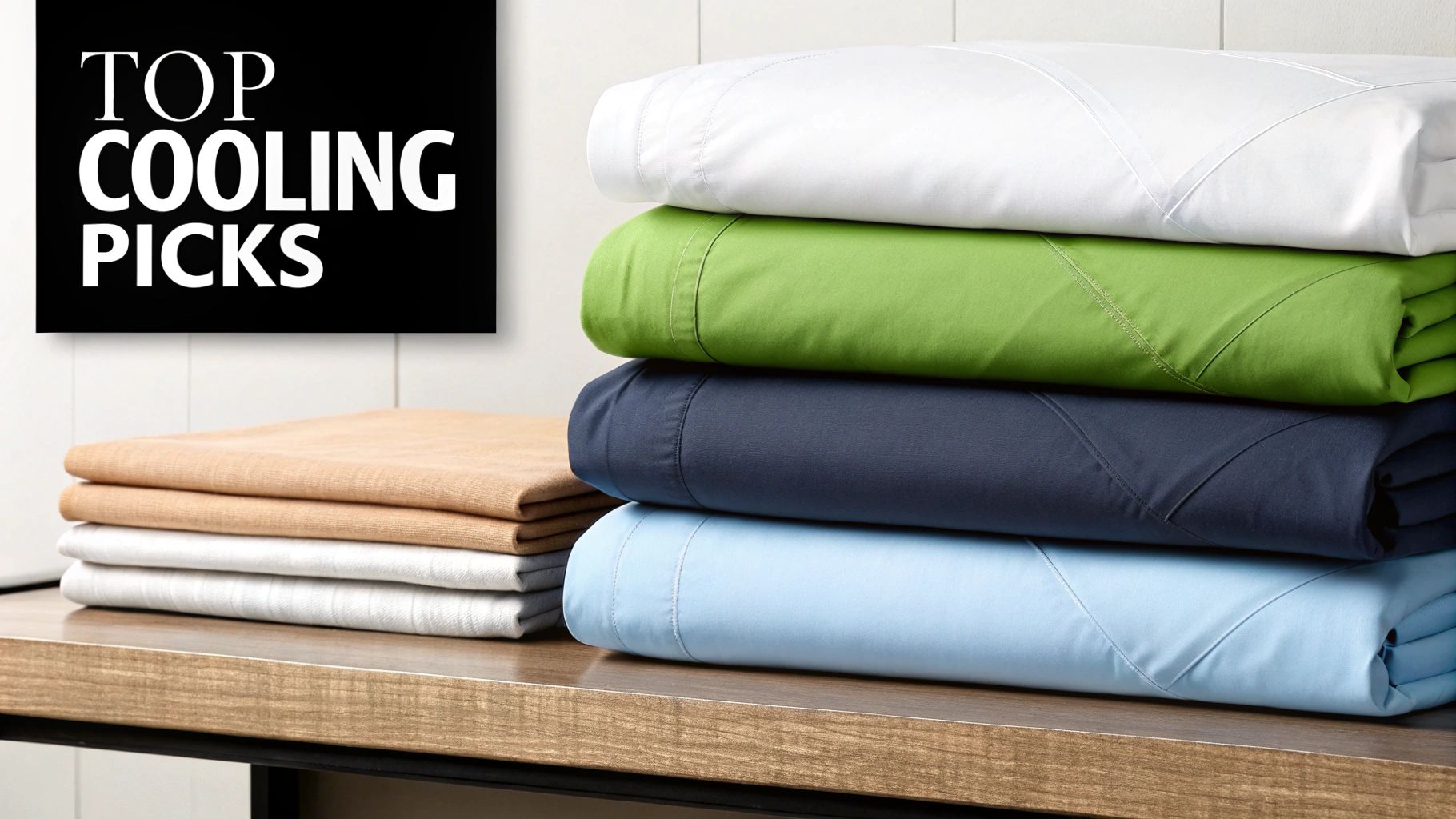If you're a hot sleeper, let's get one thing straight: the best sheets are made from natural, breathable fabrics like linen, bamboo, or TENCEL™ Lyocell. These materials are champions at wicking away moisture and letting air flow, stopping that trapped heat that leads to sticky, restless nights. Pair them with a crisp, loose percale weave, and you're on the fast track to cooler, deeper sleep.
Your Search for Cool, Comfortable Sleep Ends Here

If you've ever found yourself kicking off the covers in the middle of the night, you know the struggle is real. For hot sleepers, this frustrating battle for a comfortable temperature is an all-too-familiar story. The good news? The solution is often much simpler than you think, and it starts with your bedding. Think of this guide as your definitive resource for finally understanding how the right sheets can completely transform your sleep.
The demand for better sleep isn't just in your head, either. Here in Australia, the bedsheet market is booming, valued at over USD 2.2 billion and set to grow even more by 2033. This isn't just a random trend; it's driven by people just like you looking for sustainable, comfortable bedding—especially materials that help regulate body temperature. You can explore more data on the Australian bedsheet market and see exactly how these preferences are shaping what's available.
Why Your Sheets Matter So Much
Think of your sheets as your first line of defence against overheating. While your mattress and the room temperature definitely play a part, your sheets are what's in direct contact with your skin all night long. The wrong fabric acts like a personal insulator, trapping your body heat and creating a stuffy, humid little bubble under the covers.
The right sheets don't just feel nice—they actively work to manage heat and moisture, creating a balanced sleep environment that helps your body's natural cool-down process.
This guide will give you a clear roadmap to cut through the noise and jargon. We’ll break down:
- Natural Fibres: Why materials like linen and bamboo run circles around synthetics when it comes to staying cool.
- Weave vs. Thread Count: How the way a sheet is constructed is just as important as what it's made from.
- Actionable Advice: Practical, no-nonsense tips to help you find the perfect sheets and put an end to overheating for good.
Ultimately, choosing the best sheets for a hot sleeper is all about understanding the simple science behind cooling fabrics and making a choice that works for you.
Why You Sleep Hot and How Your Sheets Can Help
Before we dive into the best sheets for hot sleepers, let’s quickly get to the bottom of why you’re overheating in the first place. Tossing and turning in a sweaty tangle isn’t just frustrating; it’s your body’s way of saying it can't cool itself down effectively. This can be caused by anything from your metabolism and hormones to the climate in your bedroom.
While the right sheets make a massive difference, managing your room's temperature is just as vital. It's always a good idea to tick off the basics, like ensuring your AC is ready for summer, to create a genuinely cool sleep environment.
But here’s the thing: one of the biggest, most overlooked culprits is often your bedding.
Many popular sheet materials, especially synthetics like polyester, act like plastic wrap around your body. They trap your natural heat and stop sweat from escaping, creating a stuffy, humid little bubble under the covers. That’s why you wake up feeling damp and overheated, even if the room itself is cool. You can read more about why certain sheets make you sweat in our detailed guide.
The Three Superpowers of Cooling Sheets
To fight back against the heat, the best sheets for a hot sleeper have three key superpowers. Once you understand these, you can see past the marketing hype and choose bedding that actually works.
- Breathability: Think of this as ventilation for your bed. A breathable fabric lets air flow freely through its fibres, allowing excess body heat to escape instead of getting trapped.
- Moisture-Wicking: This is the fabric's ability to pull sweat away from your skin and move it to the surface, where it can evaporate. It’s what keeps you feeling dry and comfortable, not clammy.
- Thermal Conductivity: This is just a fancy term for how a fabric feels when you touch it. Materials with high thermal conductivity feel cool because they are great at drawing heat away from your body on contact.
By focusing on materials that excel in these three areas, you're not just buying new sheets. You're investing in a system designed to work with your body's own temperature regulation, leading to a much deeper, more restorative sleep.
The demand for better bedding is growing fast. The home textiles market in Australia, which includes bed linen, has hit about USD 4.92 billion. It’s set to grow as more of us prioritise materials that offer both comfort and real-world performance, like breathable cotton. Understanding these simple principles is the first real step toward finding lasting relief from night sweats.
Choosing the Best Cooling Sheet Fabrics
When you're a hot sleeper, the fabric of your sheets isn't a small detail—it's everything. Think of your bedding like athletic gear. You wouldn't wear a thick wool jumper for a run on a hot day, so why would you sleep in sheets that trap heat all night? The right fabric works with your body to regulate temperature, not against it.
This is where a little science comes in handy. The best cooling fabrics really shine in three key areas: breathability, moisture-wicking, and thermal conductivity. In simple terms, they let heat escape, pull sweat away from your skin, and feel cool to the touch.
This infographic shows just how important each of these properties is when it comes to cool, comfortable bedding.

As you can see, breathability is the real hero here. It allows air to circulate freely, stopping that stuffy, trapped feeling before it even starts.
The Top Contenders for a Cool Sleep
Let's get into the materials that consistently come out on top for hot sleepers. Each one has a unique structure that makes it a champion of cool comfort.
- Linen: Made from the flax plant, linen fibres are naturally hollow, which creates an incredible ventilation system. This structure is what gives it such exceptional airflow, making it one of the most breathable fabrics you can find. It’s also brilliant at absorbing moisture without ever feeling damp.
- Bamboo: Fabrics made from bamboo, like viscose or lyocell, are famous for their silky-smooth feel and incredible moisture-wicking power. In fact, bamboo can absorb a lot more moisture than cotton, actively pulling sweat away from your body to keep you dry all night. If you want to learn more, you can delve into bamboo bed sheets.
- TENCEL™ Lyocell: This is another superstar plant-based fibre, this time from eucalyptus wood pulp. TENCEL™ has fantastic thermal conductivity, which is just a fancy way of saying it has that signature cool-to-the-touch feel everyone loves. It pairs this with excellent moisture management and a beautiful, smooth drape.
To give you a clearer picture, here’s a quick rundown of how these fabrics stack up against each other for hot sleepers.
Cooling Fabric Comparison for Hot Sleepers
This table breaks down the top sheet fabrics, rating them on the key features that matter most for a cool night's sleep.
| Fabric Type | Breathability Rating (1-5) | Moisture-Wicking (1-5) | Feel & Texture | Best For |
|---|---|---|---|---|
| Linen | 5 | 4 | Crisp, textured, gets softer over time | Those who love an airy, natural feel and maximum airflow. |
| Bamboo | 4 | 5 | Silky, smooth, drapes beautifully | Anyone who needs serious moisture-wicking and a soft touch. |
| TENCEL™ Lyocell | 4 | 4 | Very smooth, cool to the touch, gentle | People with sensitive skin who want a cool, luxurious feel. |
| Cotton (Percale) | 4 | 3 | Light, crisp, matte finish | A classic, reliable option for a cool and crisp sleep. |
| Cotton (Sateen) | 2 | 3 | Silky, smooth, slight sheen | Those who prioritise a silky feel over maximum cooling. |
| Polyester | 1 | 1 | Can feel slick or cheap | Not recommended for hot sleepers; traps heat and moisture. |
Choosing between Linen, Bamboo, or TENCEL™ often comes down to personal preference on texture, but all three are fantastic choices for staying cool.
Understanding Bamboo Sheets Further
Bamboo sheets are a real standout because they manage to tick so many boxes at once. Their natural micro-gap structure allows air to flow consistently, which helps maintain a more neutral temperature all night long. This makes them especially good for those humid Australian nights.
It’s worth taking a closer look at what makes them so effective. To understand more about their unique properties and how they're made, check out our ultimate guide to luxury and sustainable bamboo sheets. This guide explains how the specific weave and fibre structure contribute to their cooling power.
A key advantage of bamboo is its ability to manage moisture without sacrificing softness. Unlike some materials that become stiff when they absorb sweat, bamboo remains silky and comfortable against the skin.
Fabrics to Avoid for Hot Sleepers
Just as important as knowing what to look for is knowing what to steer clear of. Some fabrics are basically kryptonite for hot sleepers, trapping heat and guaranteeing a sweaty night.
- Flannel: This one’s a no-brainer. Flannel is designed for warmth, with a brushed surface that traps air for insulation. Great for a freezing winter cabin, but a nightmare for anyone who runs hot.
- High-Thread-Count Sateen: While it might feel luxurious, a super-high thread count (we're talking 800+) means the weave is incredibly dense. That density blocks airflow, creating a barrier that traps your body heat right where you don't want it.
- Synthetic Fabrics: Materials like polyester and microfibre are essentially made from plastic. They don't breathe and they don't absorb moisture, which leads to that awful clammy, sticky feeling.
By choosing a fabric like linen, bamboo, or TENCEL™, you’re setting yourself up for success. You're creating a sleep environment that actively helps your body cool down, leading to a much more restful night.
How Weave And Thread Count Affect Cooling

It’s one of the biggest myths in bedding: the higher the thread count, the better the sheets. While it can be a marker of luxury, for a hot sleeper, a super-high thread count is often just a recipe for a stuffy, sweaty night.
The truth is, the weave of a fabric—the way the threads are actually interlaced—plays a much bigger role in keeping you cool.
Think of it like comparing a chain-link fence to a solid brick wall. The fence lets a breeze pass right through, while the wall blocks it completely. Sheet weaves work in a similar way.
Weave Wars: Percale vs. Sateen
When you're on the hunt for cooling sheets, you’ll constantly see two cotton weaves pop up: percale and sateen. Getting the difference between them is the key to a better night's sleep.
- Percale Weave: This is the chain-link fence of the bedding world. It uses a simple one-thread-over, one-thread-under grid pattern. This creates a light, crisp fabric with thousands of tiny spaces for air to circulate freely. For hot sleepers, it’s the clear winner.
- Sateen Weave: This is your brick wall. It uses a one-thread-under, three-or-four-threads-over pattern. This structure packs the threads tightly together, creating that silky-smooth, lustrous feel many people love. But that dense construction also traps body heat, making it a poor choice if you overheat.
While sateen feels incredibly luxurious, its dense weave just doesn't breathe well. For genuine cooling power, a percale weave is almost always the way to go.
The Truth About Thread Count
So, where does thread count fit into all this? Thread count is simply the number of horizontal and vertical threads woven into one square inch of fabric. A higher number means more threads are crammed into that space, creating a denser, heavier, and less breathable sheet.
For hot sleepers, the sweet spot for thread count is usually between 200 and 400. This range hits the perfect balance of softness and durability without blocking that all-important airflow you need to stay cool.
Anything over a 400-thread count often means you're sacrificing breathability for a denser feel, which can make you sleep warmer. The Australian bed linen market has seen huge growth as more people look for specific features to improve their sleep quality, and understanding these details is key.
Don’t fall for the marketing hype around ultra-high numbers. If you want a cool and comfortable sleep, focus on a breathable weave and a moderate thread count. It will serve you far better in the long run.
To dive deeper into this topic, check out our guide on understanding thread count and if it really matters.
Top Cooling Sheets For Australian Sleepers

Alright, you've got the theory down – you know all about cooling fabrics, breathable weaves, and why they matter. Now for the fun part: putting it all together to find the perfect sheets for our unique Aussie climate.
To make things simple, we’ve handpicked our top recommendations. Each one is a winner in the breathability and moisture-wicking stakes, so you can finally find the right set to put an end to those sweaty, restless nights.
Best Overall Cooling Performance
If you’re after the ultimate all-rounder – something that nails the balance between soft, breathable, and durable – you really can’t go past a quality bamboo sheet set. Bamboo fibres aren't just smooth; they have a clever micro-gap structure that basically works like a built-in ventilation system, letting air flow freely all night long.
This constant airflow is what stops body heat from getting trapped under the covers, keeping your temperature stable. On top of that, bamboo is a moisture-wicking powerhouse, absorbing far more moisture than traditional cotton. It actively pulls sweat away from your skin, so you stay dry and comfortable even on those sticky, humid nights. A brilliant example is the Morgan and Reid Cooling Sheet Set, which is engineered to make the most of these natural benefits.
Best for a Luxe Feel
For those who love that silky-smooth, five-star hotel feeling but refuse to compromise on cooling, TENCEL™ Lyocell is the answer. Made from eucalyptus wood pulp, TENCEL™ is famous for its incredible thermal conductivity.
What does that mean? It has a natural ability to feel cool to the touch. The moment you slip into bed, it starts drawing heat away from your body, offering instant relief for anyone who feels hot and bothered at night.
But it’s not just about that initial cool touch. TENCEL™ also drapes beautifully over the body and feels incredibly gentle, which is a huge plus for sensitive skin. It’s the perfect blend of luxury and serious temperature regulation.
Best Budget-Friendly Option
You don’t have to spend a fortune to get a cool night’s sleep. A classic cotton percale sheet set is still one of the most effective and wallet-friendly choices out there for hot sleepers.
The secret is in its simple, grid-like percale weave. The one-thread-over, one-thread-under structure creates a fabric that’s crisp, lightweight, and exceptionally breathable. It won’t have the silky drape of bamboo or TENCEL™, but its matte finish and airy feel are exactly what you need to promote airflow. Just look for a thread count between 200 and 400 – this hits the sweet spot for softness and breathability without becoming too dense and trapping heat.
Most Eco-Conscious Choice
If sustainability is high on your list, you can’t go wrong with pure linen sheets. Linen is made from the flax plant, which is incredibly resilient and requires far less water and fewer pesticides to grow than conventional cotton.
Its cooling magic comes from its naturally hollow fibres, which act like tiny straws, allowing air to pass through easily. It’s one of the most breathable fabrics you can find, and it has the unique quality of getting softer and more comfortable with every single wash. Linen has a more relaxed, rustic texture, but its durability and green credentials make it a fantastic long-term investment for a cool and conscious sleep.
Caring For Your Sheets to Maximise Cooling
So, you've invested in a great set of cooling sheets. Brilliant! Now, let's make sure they keep performing at their best for years to come. Looking after them properly is key to protecting those clever natural fibres that work so hard to keep you comfortable all night long.
A few simple tweaks to your laundry routine can make all the difference. For instance, always wash your sheets in cool or warm water—never hot. High temperatures can damage delicate materials like linen and bamboo over time, which means they’ll lose that signature softness and breathability.
Simple Steps for Lasting Coolness
Here’s another big tip: skip the fabric softener. It might seem like a good idea, but liquid softeners and dryer sheets are known for leaving behind a waxy residue that clogs up the fabric's pores. That build-up actually traps heat and moisture, which is the very last thing any hot sleeper wants.
Think of it like this: fabric softener blocks the tiny airways in your sheets, suffocating their ability to breathe and wick away moisture.
Instead, get into these simple habits:
- Line-dry when you can: Sunlight is a natural sanitiser, and air-drying is fantastic for helping materials like linen maintain their unique texture and cooling structure.
- Use a gentle detergent: Harsh chemicals can be pretty tough on natural fibres.
- Tumble dry on low: If you have to use a dryer, always choose the lowest heat setting to prevent any damage.
These easy steps will go a long way in protecting your investment. You can find even more advice in our guide on caring for your bed sheets in our guide.
Common Questions About Cooling Sheets
Even with all the details covered, a few questions always seem to pop up when you’re hunting for the right sheets. Getting these sorted can make that final decision a whole lot easier and ensure you're investing in something that actually works. Let’s tackle some of the most common ones.
Are 1000 Thread Count Sheets Good for Hot Sleepers?
Not usually. While it sounds incredibly luxurious, a 1000 thread count creates such a dense fabric that there’s simply nowhere for air to go. Think of it like trying to breathe through a solid wall—it just traps heat right next to your skin.
You'll get a much cooler sleep by opting for a lower thread count, somewhere in the 200-400 range, especially in a crisp percale weave. This combination feels significantly lighter and more refreshing, allowing air to circulate freely all night long.
What Sheet Material Feels Coolest to the Touch?
If you’re after that instant ahhh feeling when you slip into bed, materials like TENCEL™ Lyocell and bamboo are your best bet. They have high thermal conductivity, which is just a fancy way of saying they’re brilliant at pulling heat away from your body on contact.
That initial cool-to-the-touch sensation can be a game-changer. It offers immediate relief and helps you relax and drift off faster, skipping that uncomfortable period of tossing and turning while you overheat.
Is It Better to Sleep Without a Top Sheet if I Get Hot?
It might seem like a good idea, but this can often backfire. A good quality top sheet made from a moisture-wicking fabric like linen or TENCEL™ is actually your best friend for managing sweat.
It works by pulling moisture away from your body, keeping you far drier and more comfortable than sleeping directly under a duvet. Your doona will just soak up sweat, feel damp, and is a lot harder to wash regularly than a simple top sheet.
Ready to feel the difference a truly cooling sheet set can make? The Manchester Factory has a curated collection of bamboo, linen, and TENCEL™ sheets designed to give you a comfortable, sweat-free night's sleep. Explore our range of cooling bedding and find your perfect match today!

